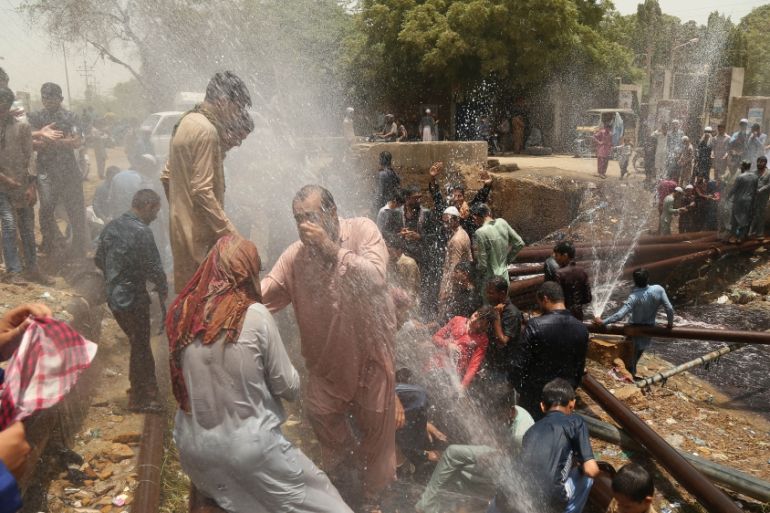At least 60 dead as Pakistan’s Karachi sizzles in heatwave
Death toll expected to climb, officials say, as heatwave coincides with Ramadan and electricity cuts.

Islamabad, Pakistan – At least 60 people have died of heat-related illnesses in the southern Pakistani city of Karachi in the last four days, rescue officials say, as temperatures soared to 44 degrees Celsius in the country’s largest city.
The spike in temperatures has coincided with the month of Ramadan, with Muslims who fast in the coastal metropolis taking no food or water for almost 15 hours every day.
Keep reading
list of 4 itemsAsia bears biggest climate-change brunt amid extreme weather: WMO
Photos: Highest-level rainstorm warning issued in south China’s Guangdong
Europe endured record number of ‘extreme heat stress’ days in 2023
Most of those who have died so far during the heat wave were elderly or had existing health complications, said Faisal Edhi, chief of the Edhi Foundation rescue service, on Wednesday.
In June 2015, more than 1,200 people died of heat-related illnesses in Karachi during a similar heat wave.
The intense heat and deaths this year have sparked concerns that the situation could spiral, as it did during the 2015 heat wave, when hospital officials said that mortuaries were overflowing and public sector hospitals were overwhelmed with thousands of patients every day.
“There is no awareness among people that they must not enter the direct sunlight, and need to keep their skin moist as this is a very dry heat,” Edhi told Al Jazeera by telephone.
Prolonged power outages have also plagued parts of the city, as electricity consumption has risen, further exacerbating citizens’ woes.
Government disputes toll
The government disputes the death toll, saying many of the deaths were due to underlying conditions, and not heat stroke or dehydration.
“We have verified that a number of them were patients of other conditions … some of them were genuine cases, but not all of them,” said Ejaz Ahmed, an official at the Karachi commissioner’s office.
Shahid Abbas, a senior official at Pakistan’s Meteorological Department, said the heat wave was expected to continue for at least another 48 hours, and had been caused by an incoming northwesterly hot weather system and a corresponding drop in the coastal city’s sea breeze.
“The main reason was that the moisture was low, and dry air heats up quite quickly,” he said.
Temperatures of up to 41 degrees Celsius are expected to continue until at least Friday, the Meteorological Department said.
Urban heat islands
Rescue officials are advising those who fast to avoid prolonged exposure to direct sunlight, and to keep their skin, particularly on their heads and faces, moist. Roughly 96 percent of Pakistan’s 207 million population is Muslim, according to a government census, with many observing Ramadan.
“There is a religious reason to this as well, as people who are fasting are very badly affected by the heat,” said Edhi.
The government says it has set up dozens of camps across the city where they are providing water and basic medication to those feeling the effects of the heat.
Experts point to the ‘urban heat island’ phenomenon as one reason why Karachi has experienced such intense heat waves in the recent past.
‘Urban heat islands‘ are high population areas which typically see higher temperatures than their surrounding rural region, due to the build-up of excess heat by their inhabitants and industrial processes, and the clearing of trees and vegetation that can keep moisture in and provide shade to keep those areas cool.
Karachi, a city of roughly 18 million people, is Pakistan’s largest metropolis and its economic backbone. Spread over 3,000 square kilometres near the Indus delta into the Arabian Sea, its sprawl consists of a mix of high-rise apartment buildings, vast low-income housing neighbourhoods, industrial areas and luxurious homes in its richer southern district.
“The construction of high-rises and the manner it has been done it is [mainly] at fault,” says Arif Hasan, one of the city’s pre-eminent architects and urban planners. “All the low income settlements, with very narrow streets, are all becoming high rises.”
Where there were once open areas and single storey homes, Hasan says, the space has vanished in the narrow streets of the city’s neighbourhoods, which traps hot air with nowhere to go.
“[We need to] introduce a tradition of having cross ventilation … you look at all the old buildings, even in the older parts of town with narrow streets, they had cross ventilation because they knew that they needed it.”
Asad Hashim is Al Jazeera’s digital correspondent in Pakistan. He tweets @AsadHashim.